Scientists Revealed Structural Dynamics and Electronic Bandgap Contraction of Boron Nitride Nanotubes
Date:25-11-2019 Print
Low-dimensional materials exhibit remarkable physical properties that have been used to fabricate novel optoelectronic devices. Seeing the structural dynamic processes in nanomaterials can provide key information for the development of high-performance low-dimensional material-based devices. As a typical one-dimensional material, boron nitride nanotube is a wideband semiconductor with well-known thermal, mechanical, and chemical properties. Because of the extensive application prospects of boron nitride nanotubes, understanding their ultrafast structural and electronic dynamics will benefit to designing and engineering nanotube-based functional devices.
Ultrafast transmission electron microscopy (UTEM), ultrafast electron diffraction (UED) and ultrafast x-ray diffraction (UXRD) are widely used in structural dynamic investigations. The UXRD and UED track the lattice dynamics in diffraction space, and the UTEM can study ultrafast dynamics in the diffraction space, the real space (image) and the energy space (electron energy-loss spectroscopy). Prof. LI Jianqi’s group from the Institute of Physics, Chinese Academy of Sciences (IOP, CAS) is working on developing high-performance UTEM. They had built the first home-made UTEM of China in 2014, and obtained an international patent (No. PCT/CN2014/076846/US9, 558, 909B2) and a Chinese patent (ZL201410007919.2). Several significant progresses in revealing the structural dynamics of novel materials have been achieved using their UTEMs, e.g. (1) Dr. LI Zhongwen, Prof. XIAO Ruijuan et al studied the structural dynamics in nanomaterials using the electron diffraction, they had revealed the electron-driven lattice expansion processes and the electron-phonon coupling in carbon nanotubes and in boron nitride nanotubes [ Nanoscale 9, 13313 (2017); Nanoscale 10, 7465 (2018); ACS Nano 13, 11623 (2019)]; Dr. ZHANG Ming and Prof. LI Zian characterized magnetic dynamics in Mn-Ni-Ga under a sub-picosecond temporal and sub-50-nm spatial resolution using Lorentz ultrafast transmission electron microscopy [Phys. Rev. Appl. 12, 034037 (2019)]; Dr. ZHU Chunhui and ZHENG Dingguo et al. worked on a new-generation UTEM, and investigated photon-induced-near-field electron microscopy [Ultramicroscopy 209, 112887 (2020)].
Recently, Prof. LI Jianqi’s group made another significant progress in the structural dynamics of boron nitride nanotubes. Using femtosecond/nanosecond modes with a stroboscopic configuration, they revealed the entire reversible cycle for structural evolution (Figure 1). This cycle exhibits four stages (Figure 2), i.e. a rapid electron-driven transient process in the early stage (~ <20 ps), an Auger recombination process (~ 20-500 ps), a quasi-thermal equilibrium stage (~ 500 ps-100 ns) and a thermal diffusion process (~ 100 ns-10 μs).
The non-thermal lattice expansion processes of boron nitride nanotubes are very different to that of carbon nanotubes. There is a ~ 15 ps delay between the time that reached the maximum radical contraction and the maximum axial expansion (Figure 3). By three-photon absorption, the pump laser promotes electron from valence (π) band to conduction (π*) band. On one hand, these photoinduced carriers can increase charge density in π*-bond and weaken intralayer B-N bond, thus leading to axial expansion. On the other hand, the increased charge density in the σ-bond perpendicular to the axial direction strengthens the interlayer interaction, thus resulting in radical contraction (Figure 3 and 4). After the radical contraction reached the maximum, high-energy photoinduced σ* carriers will relax to low-energy π* state by carrier diffusion and electron-phonon coupling processes. While this carriers’ relaxation process can recovery of radical contraction, the axial expansion still increases owing to the increased carrier density in π*-bond. This axial expansion continues until all of the high-energy state electrons back to the low-energy state. The time constant of the axial expansion matches the summary of the time constant of radical contraction and the time constant of electron-phonon coupling. After this process, photoinduced carriers relax from π*-bond to π-bond, and the nonthermal lattice expansion gradually receded.
Using time-resolved electron energy-loss spectroscopy, they found an obviously the bandgap contraction in this nanotube upon femtosecond laser excitation. The temporal electronic bandgap contraction is similar to that of nonthermal electron-driven lattice expansion (Figure 5). This result suggests that an inherent relationship may exist between the photoinduced electronic structure change and the photoinduced lattice change.
This study entitled "Lattice dynamics and contraction of energy bandgap in photoexcited semiconducting boron nitride nanotubes" was published in ACS Nano [ACS Nano 13, 11623 (2019)].
Web link:https://pubs.acs.org/doi/full/10.1021/acsnano.9b05466
UTEM equipment: https://doi.org/10.1016/j.ultramic.2019.112887
These works were supported by the National Key Research and Development Program of China, the National Basic Research Program of China, the National Natural Science Foundation of China, the Strategic Priority Research Program (B) of the Chinese Academy of Sciences, the Scientific Instrument Developing Project of the Chinese Academy of Sciences, and the China Postdoctoral Science Foundation.
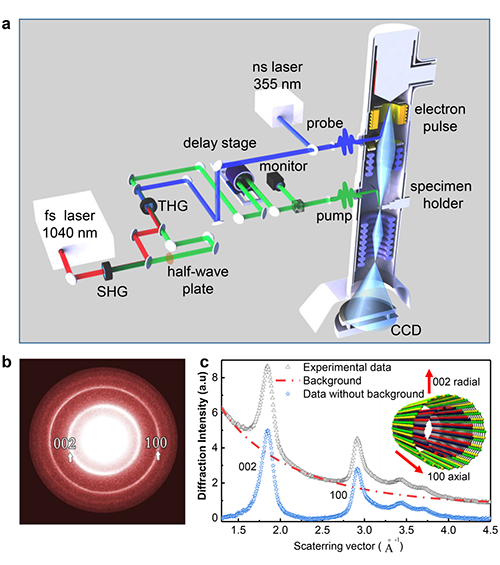 |
| Fig. 1 | Schematic illustration of ultrafast transmission electron microscope (UTEM) and diffraction pattern with data processing methods for boron nitride nanotubes. (Image by Institute of Physics) |
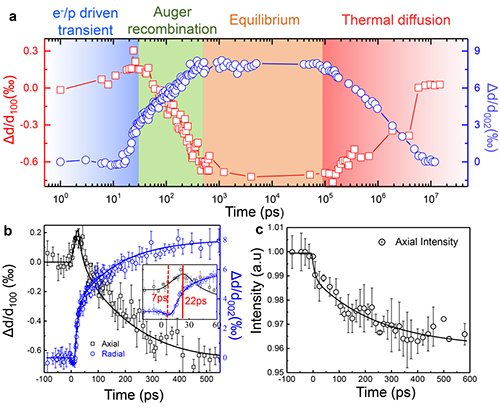 |
| Figure 2 | Experimental results of ultrafast structural dynamics in boron nitride nanotubes upon pulsed femtosecond/nanosecond laser excitation. (Image by Institute of Physics) |
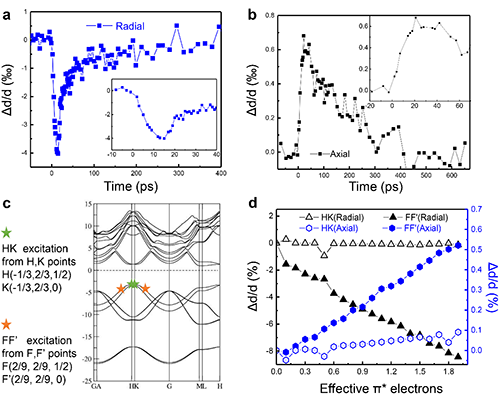 |
| Figure 3 | Nonthermal components extracted from Figure 2a after subtraction of the thermal contribution to the total lattice change. (Image by Institute of Physics) |
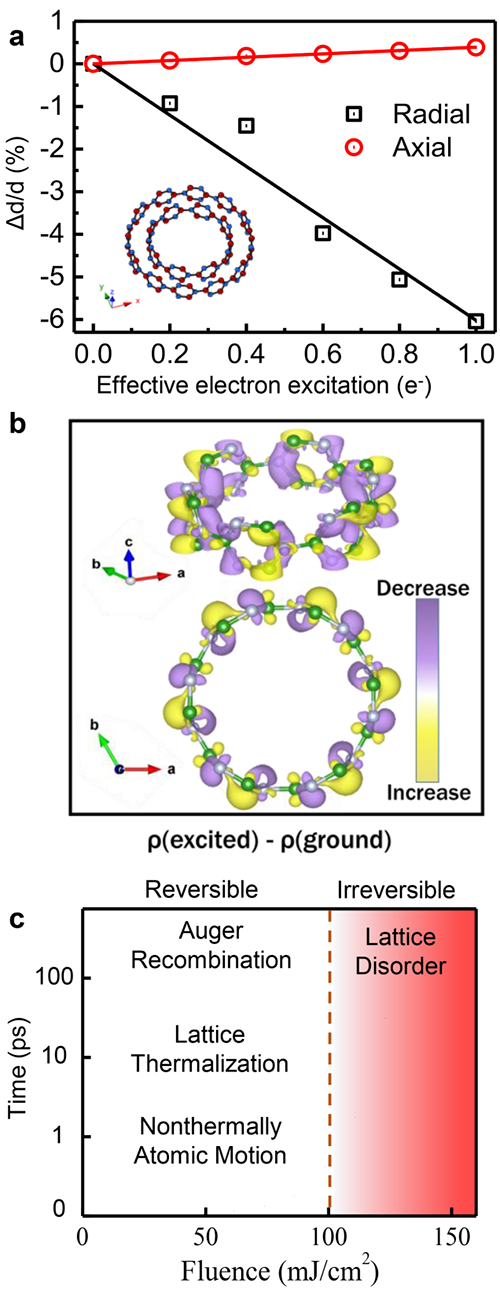 |
| Fig.4 Theoretical investigations and laser fluence dependence of structural changes in boron nitride nanotubes. (Image by Institute of Physics) |
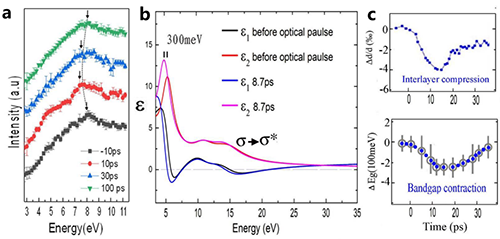 |
| Fig. 5 Time-resolved analysis of electronic structural changes in boron nitride nanotubes. (Image by Institute of Physics) |


